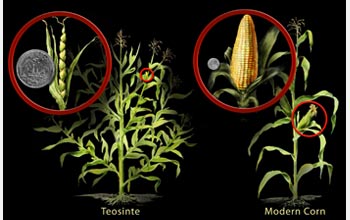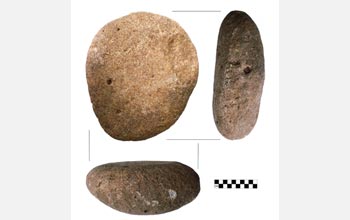All Images


Press Release 09-049
Wild Grass Became Maize Crop More Than 8,700 Years Ago

Probably domesticated in the Mexican tropical forest
Back to article | Note about images
 |
Indigenous peoples living in the lowland areas of southwestern Mexico may have cultivated corn or maize more than 8,700 years ago according to new research. Molecular biologists recently identified a large, wild grass called Balsas teosinte as the ancestor of maize. The suppression of branching from the stalk resulted in a lower number of ears per plant but allows each ear to grow larger. The hard case around the kernel disappeared over time. Today, maize has just a few ears of corn growing on one unbranched stalk.
Credit: Credit: Nicolle Rager Fuller, National Science Foundation |
Download the high-resolution JPG version of the image. (651 KB)
|
Use your mouse to right-click (Mac users may need to Ctrl-click) the link above and choose the option that will save the file or target to your computer.
|
 |
Researchers focused on excavating the Xihuatoxtla Shelter in an area of the Balsas Valley in southwestern Mexico. Searching this lowland site represented a shift from previous searches in the Mexican highlands. The Xihuatoxtla archaeological site yielded evidence of maize and squash dating back 8,700 years, representing the earliest remains of maize yet discovered.
Credit: Credit: Anthony J. Ranere, Anthropology Department, Temple University |
Download the high-resolution JPG version of the image. (851 KB)
|
Use your mouse to right-click (Mac users may need to Ctrl-click) the link above and choose the option that will save the file or target to your computer.
|
 |
This 8,700 year-old milling stone was used to process maize and other crops. Maize starch grains were recovered from the cracks and crevasses in the slightly concave surface of the tool.
Credit: Anthony J. Ranere, Anthropology Department, Temple University |
Download the high-resolution JPG version of the image. (2.5 MB)
|
Use your mouse to right-click (Mac users may need to Ctrl-click) the link above and choose the option that will save the file or target to your computer.
|
 |
Researchers identified maize and other plant species by examining phytoliths and starch grains found in the Xihuatoxtla Shelter in southwestern Mexico. Starch grains and phytoliths are microscopic particles that occur in leafs, stems and roots of many plants.
Credit: Credit: Dolores Piperno |
Download the high-resolution JPG version of the image. (55 KB)
|
Use your mouse to right-click (Mac users may need to Ctrl-click) the link above and choose the option that will save the file or target to your computer.
|
|





